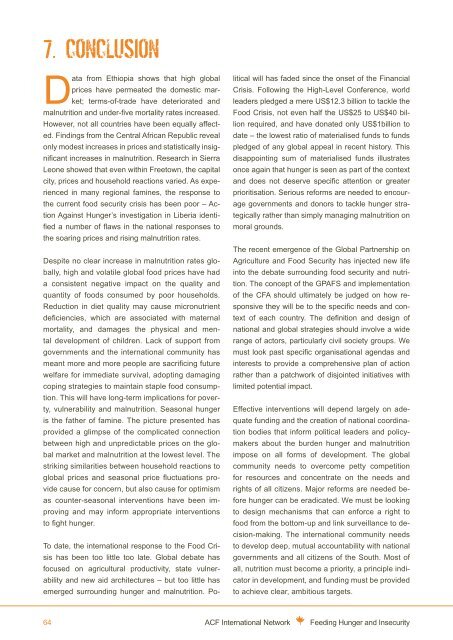Feeding hunger and insecurity
Feeding hunger and insecurity
Feeding hunger and insecurity
- No tags were found...
Create successful ePaper yourself
Turn your PDF publications into a flip-book with our unique Google optimized e-Paper software.
7. ConclusionData from Ethiopia shows that high globalprices have permeated the domestic market;terms-of-trade have deteriorated <strong>and</strong>malnutrition <strong>and</strong> under-five mortality rates increased.However, not all countries have been equally affected.Findings from the Central African Republic revealonly modest increases in prices <strong>and</strong> statistically insignificantincreases in malnutrition. Research in SierraLeone showed that even within Freetown, the capitalcity, prices <strong>and</strong> household reactions varied. As experiencedin many regional famines, the response tothe current food security crisis has been poor – ActionAgainst Hunger’s investigation in Liberia identifieda number of flaws in the national responses tothe soaring prices <strong>and</strong> rising malnutrition rates.Despite no clear increase in malnutrition rates globally,high <strong>and</strong> volatile global food prices have hada consistent negative impact on the quality <strong>and</strong>quantity of foods consumed by poor households.Reduction in diet quality may cause micronutrientdeficiencies, which are associated with maternalmortality, <strong>and</strong> damages the physical <strong>and</strong> mentaldevelopment of children. Lack of support fromgovernments <strong>and</strong> the international community hasmeant more <strong>and</strong> more people are sacrificing futurewelfare for immediate survival, adopting damagingcoping strategies to maintain staple food consumption.This will have long-term implications for poverty,vulnerability <strong>and</strong> malnutrition. Seasonal <strong>hunger</strong>is the father of famine. The picture presented hasprovided a glimpse of the complicated connectionbetween high <strong>and</strong> unpredictable prices on the globalmarket <strong>and</strong> malnutrition at the lowest level. Thestriking similarities between household reactions toglobal prices <strong>and</strong> seasonal price fluctuations providecause for concern, but also cause for optimismas counter-seasonal interventions have been improving<strong>and</strong> may inform appropriate interventionsto fight <strong>hunger</strong>.To date, the international response to the Food Crisishas been too little too late. Global debate hasfocused on agricultural productivity, state vulnerability<strong>and</strong> new aid architectures – but too little hasemerged surrounding <strong>hunger</strong> <strong>and</strong> malnutrition. Politicalwill has faded since the onset of the FinancialCrisis. Following the High-Level Conference, worldleaders pledged a mere US$12.3 billion to tackle theFood Crisis, not even half the US$25 to US$40 billionrequired, <strong>and</strong> have donated only US$1billion todate – the lowest ratio of materialised funds to fundspledged of any global appeal in recent history. Thisdisappointing sum of materialised funds illustratesonce again that <strong>hunger</strong> is seen as part of the context<strong>and</strong> does not deserve specific attention or greaterprioritisation. Serious reforms are needed to encouragegovernments <strong>and</strong> donors to tackle <strong>hunger</strong> strategicallyrather than simply managing malnutrition onmoral grounds.The recent emergence of the Global Partnership onAgriculture <strong>and</strong> Food Security has injected new lifeinto the debate surrounding food security <strong>and</strong> nutrition.The concept of the GPAFS <strong>and</strong> implementationof the CFA should ultimately be judged on how responsivethey will be to the specific needs <strong>and</strong> contextof each country. The definition <strong>and</strong> design ofnational <strong>and</strong> global strategies should involve a widerange of actors, particularly civil society groups. Wemust look past specific organisational agendas <strong>and</strong>interests to provide a comprehensive plan of actionrather than a patchwork of disjointed initiatives withlimited potential impact.Effective interventions will depend largely on adequatefunding <strong>and</strong> the creation of national coordinationbodies that inform political leaders <strong>and</strong> policymakersabout the burden <strong>hunger</strong> <strong>and</strong> malnutritionimpose on all forms of development. The globalcommunity needs to overcome petty competitionfor resources <strong>and</strong> concentrate on the needs <strong>and</strong>rights of all citizens. Major reforms are needed before<strong>hunger</strong> can be eradicated. We must be lookingto design mechanisms that can enforce a right tofood from the bottom-up <strong>and</strong> link surveillance to decision-making.The international community needsto develop deep, mutual accountability with nationalgovernments <strong>and</strong> all citizens of the South. Most ofall, nutrition must become a priority, a principle indicatorin development, <strong>and</strong> funding must be providedto achieve clear, ambitious targets.64ACF International Network<strong>Feeding</strong> Hunger <strong>and</strong> Insecurity

















